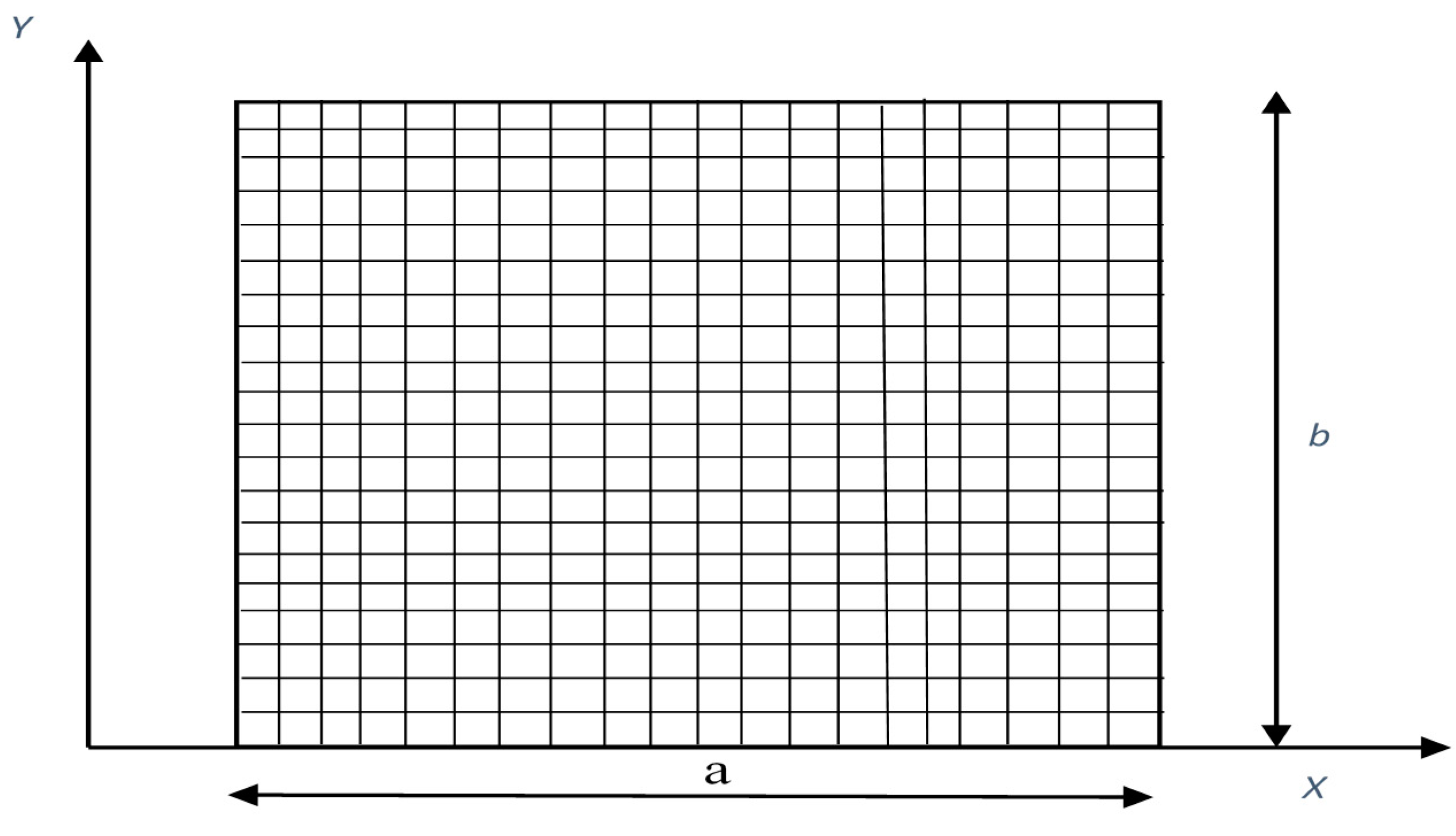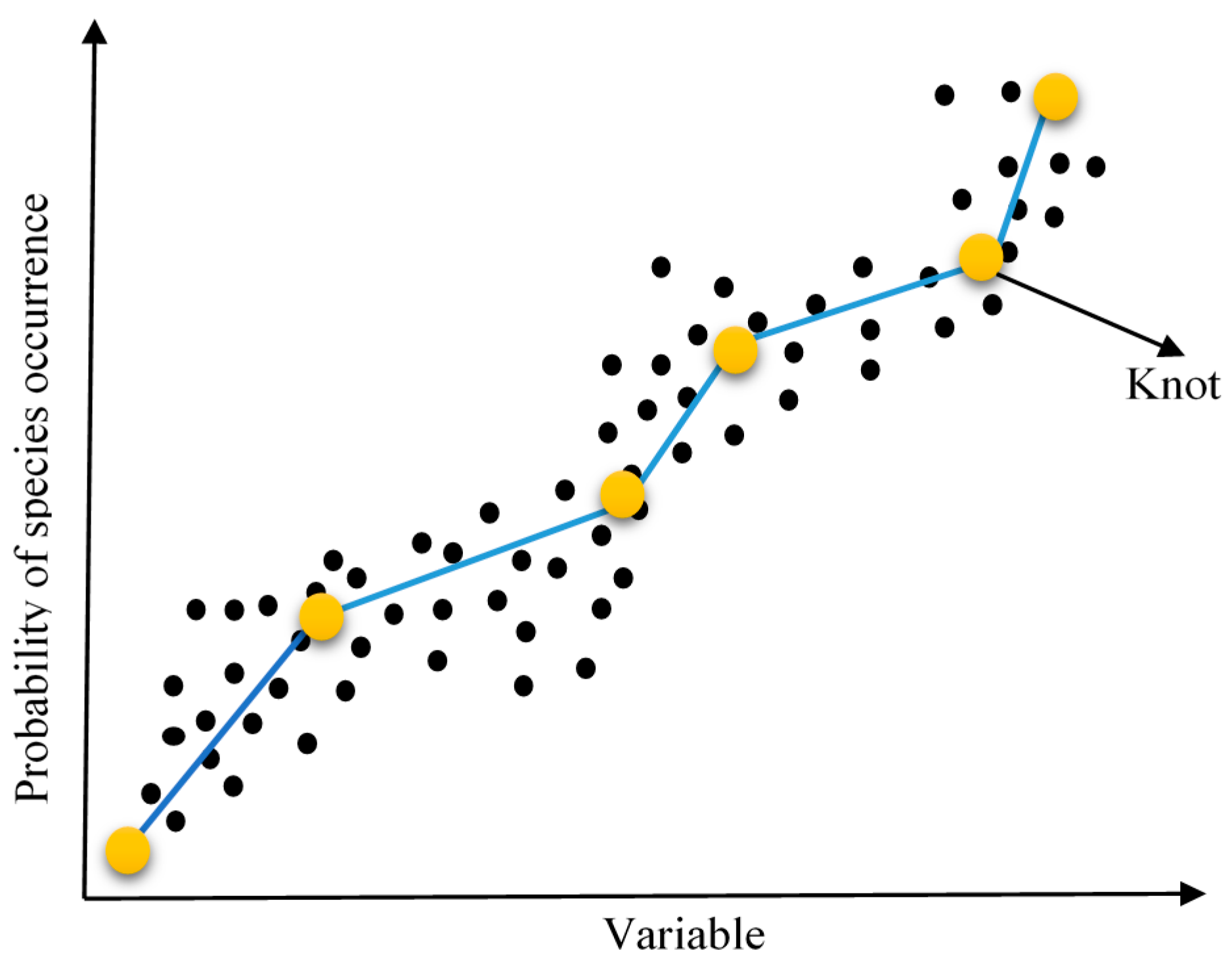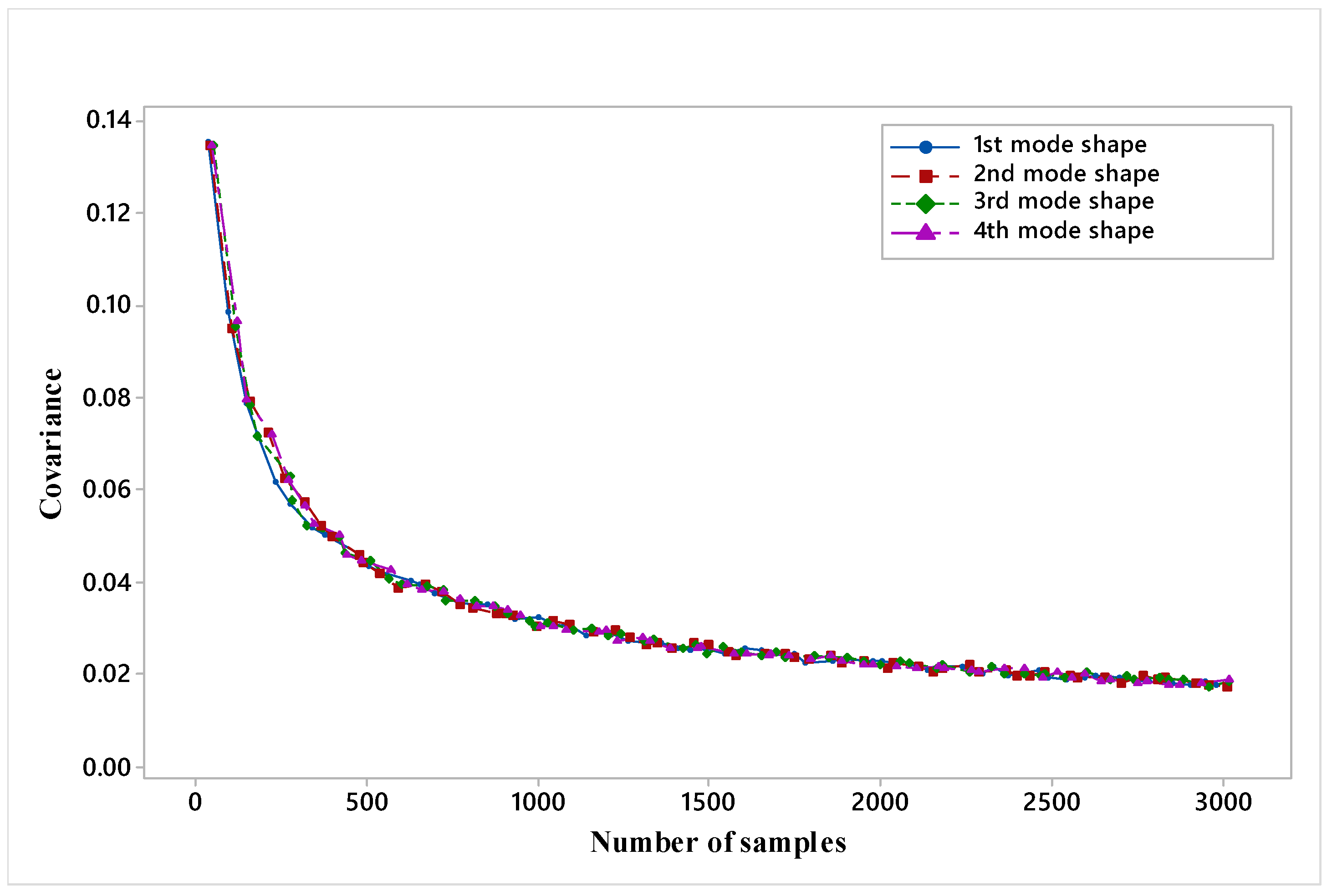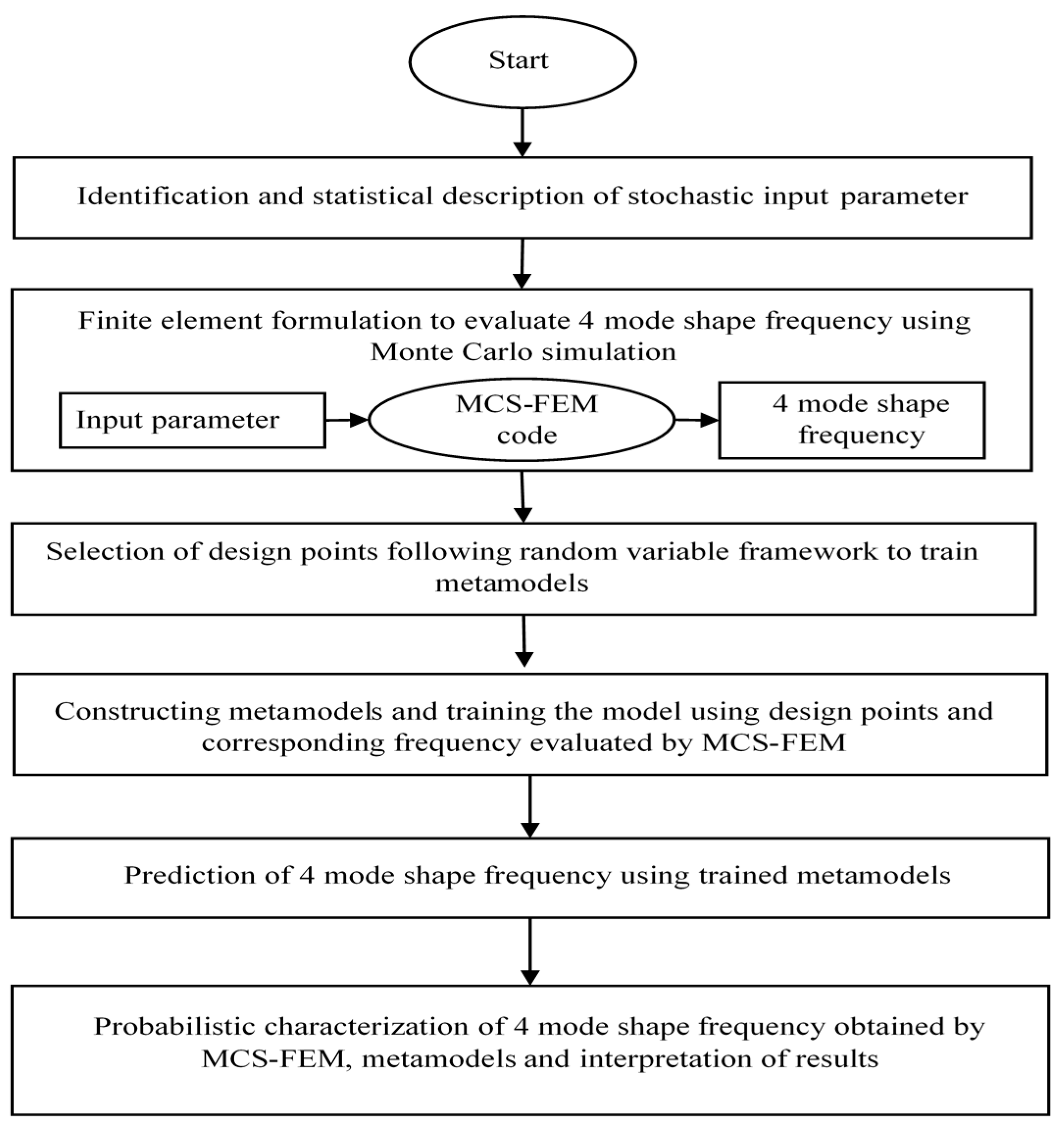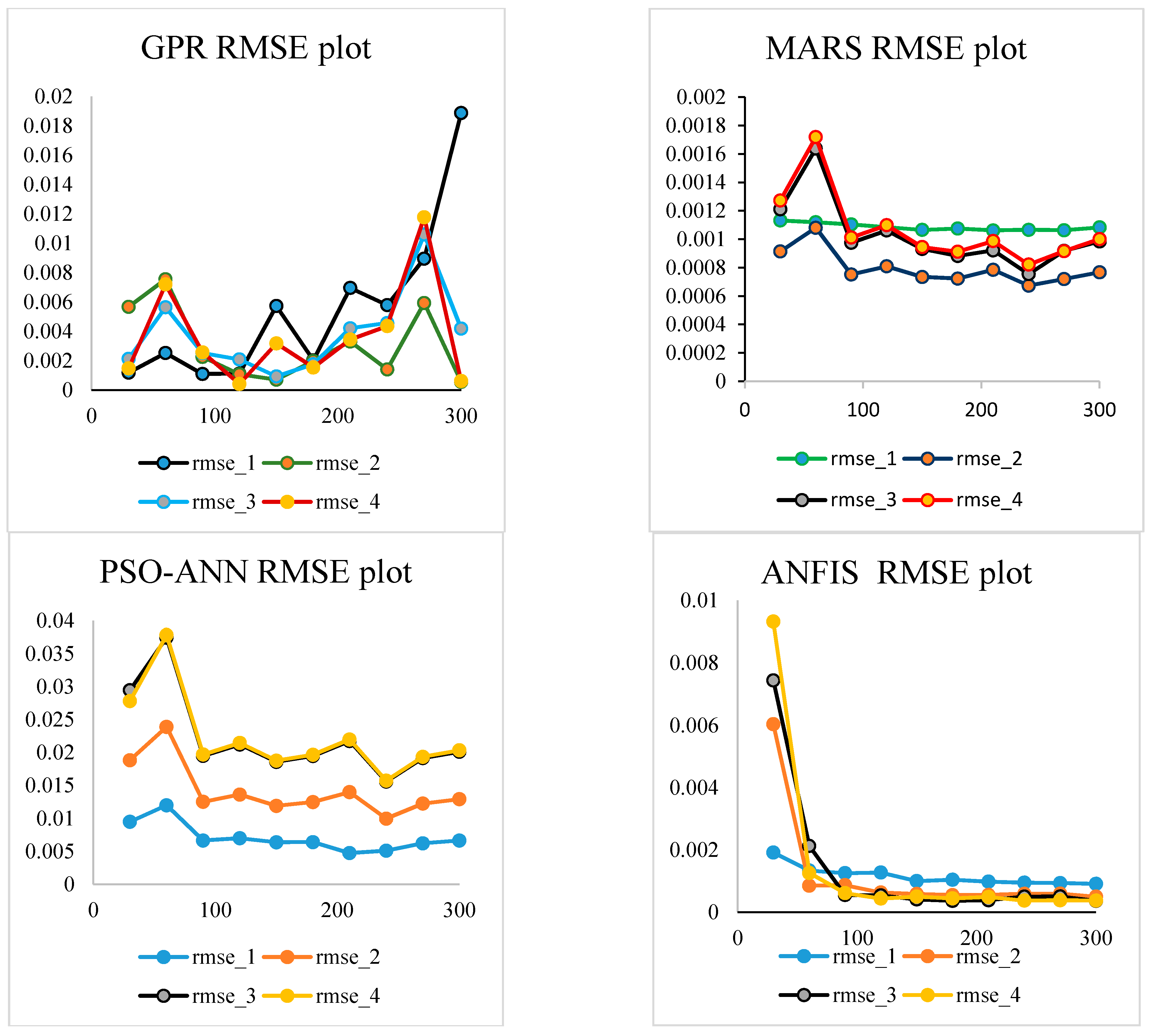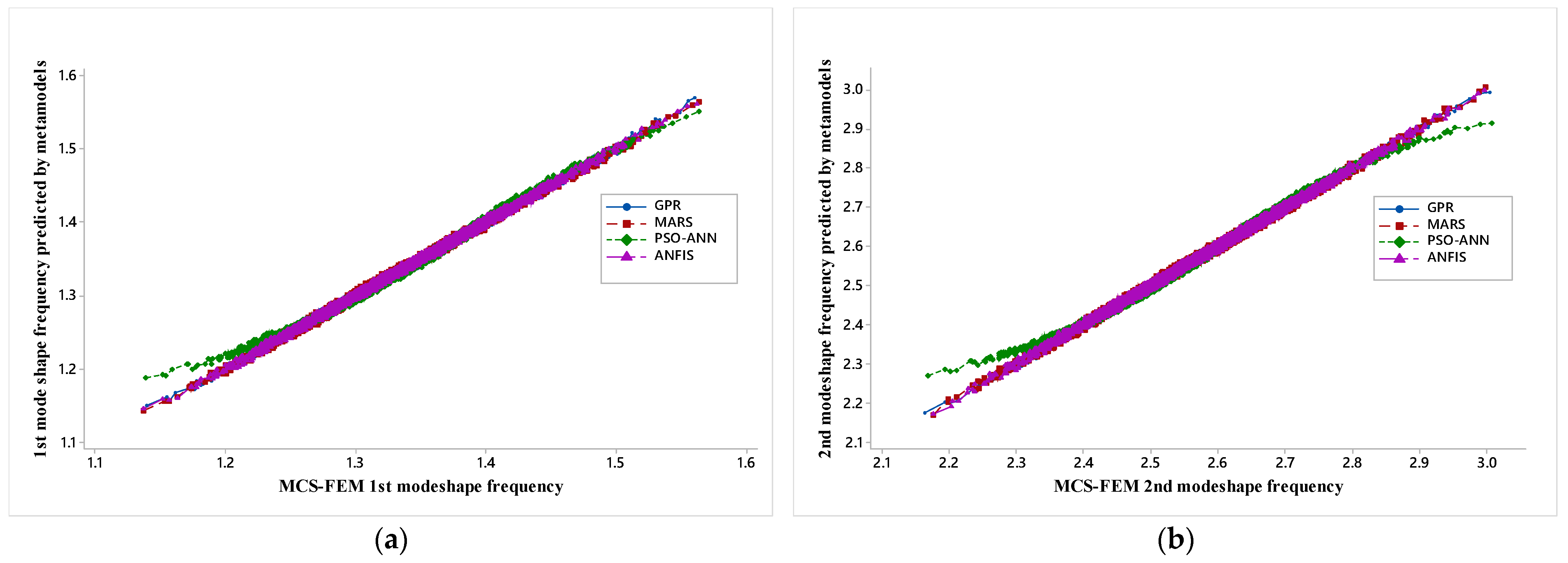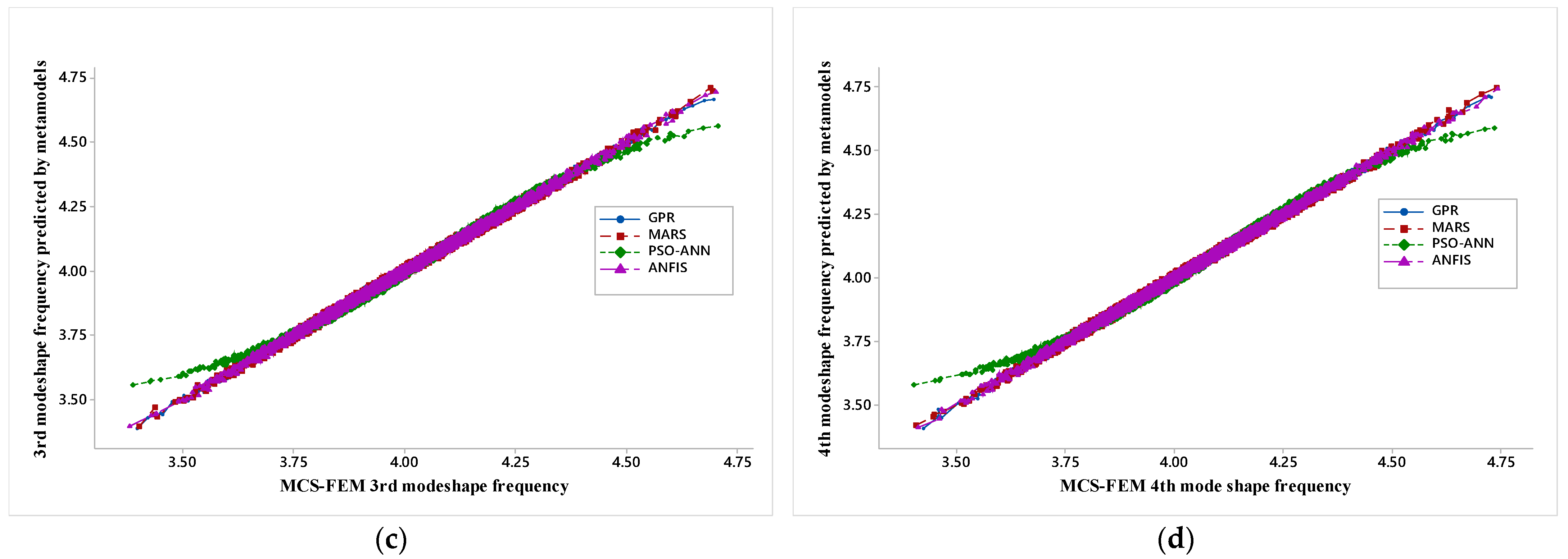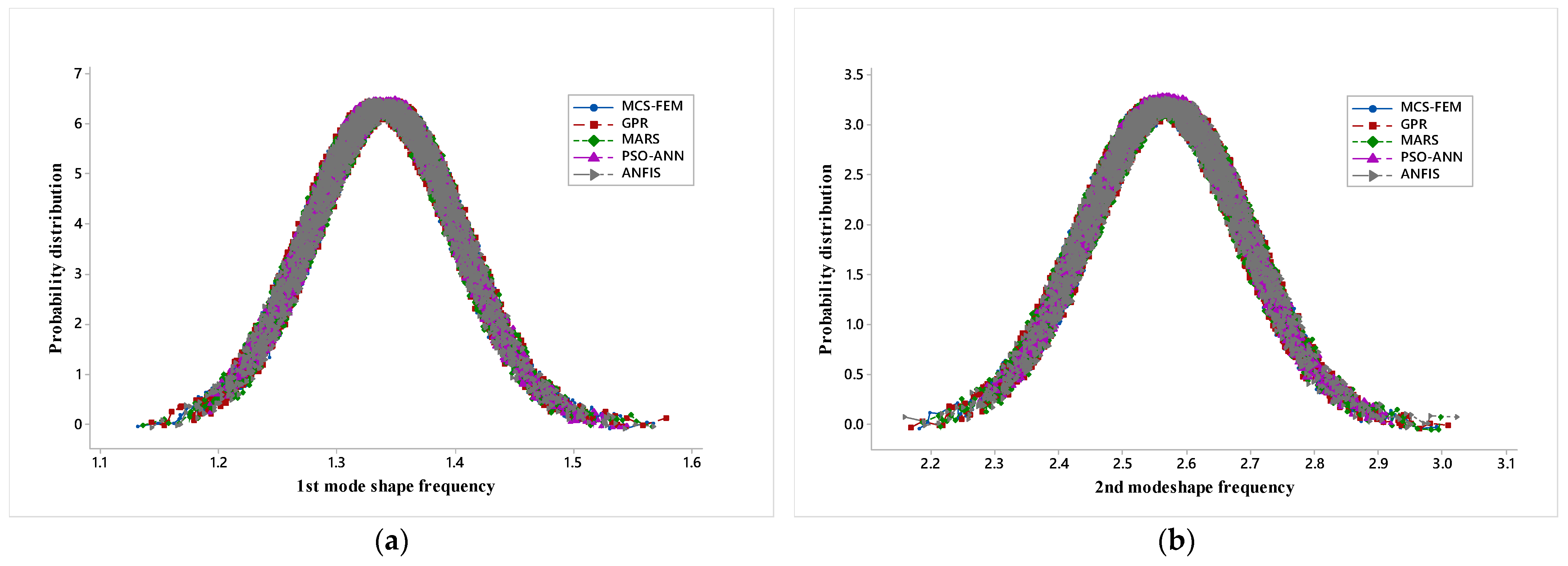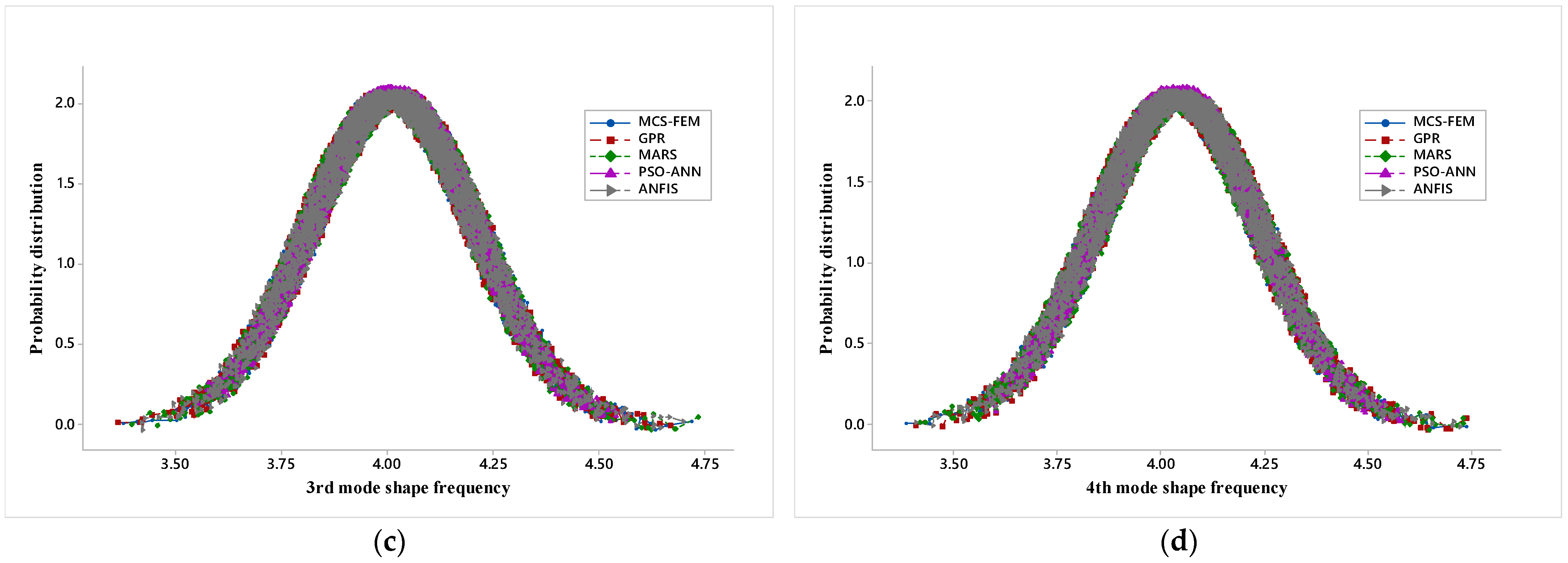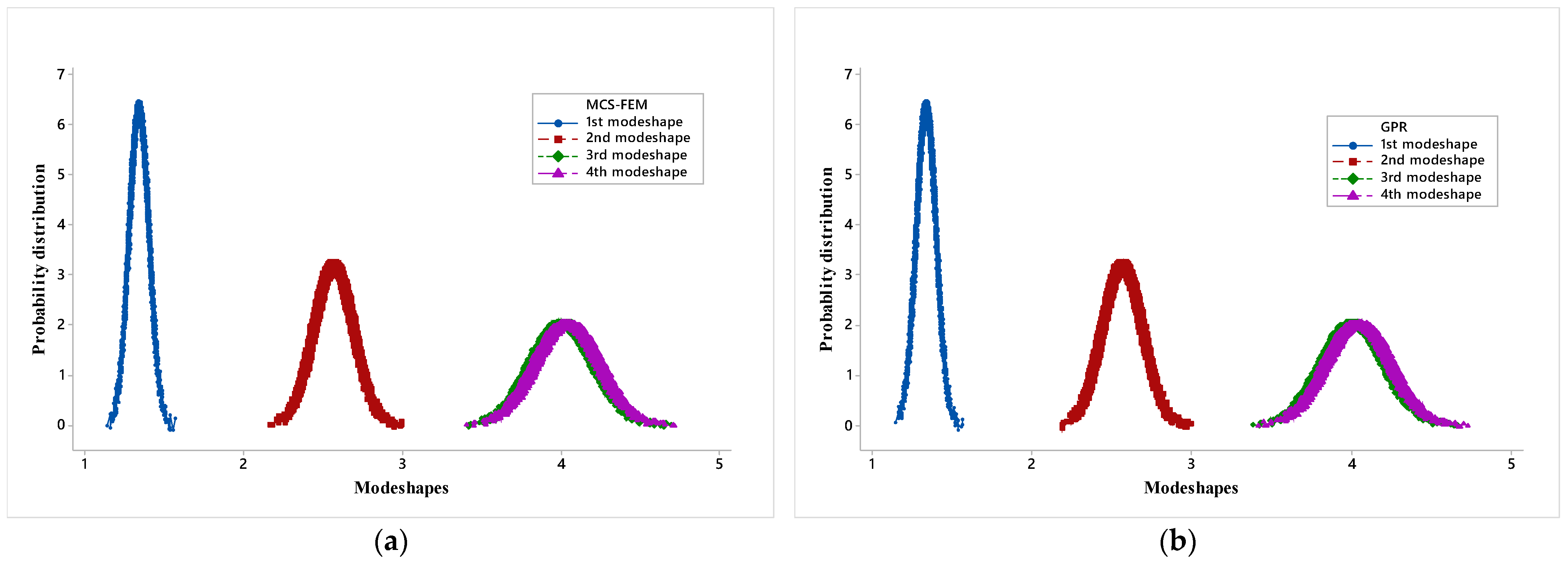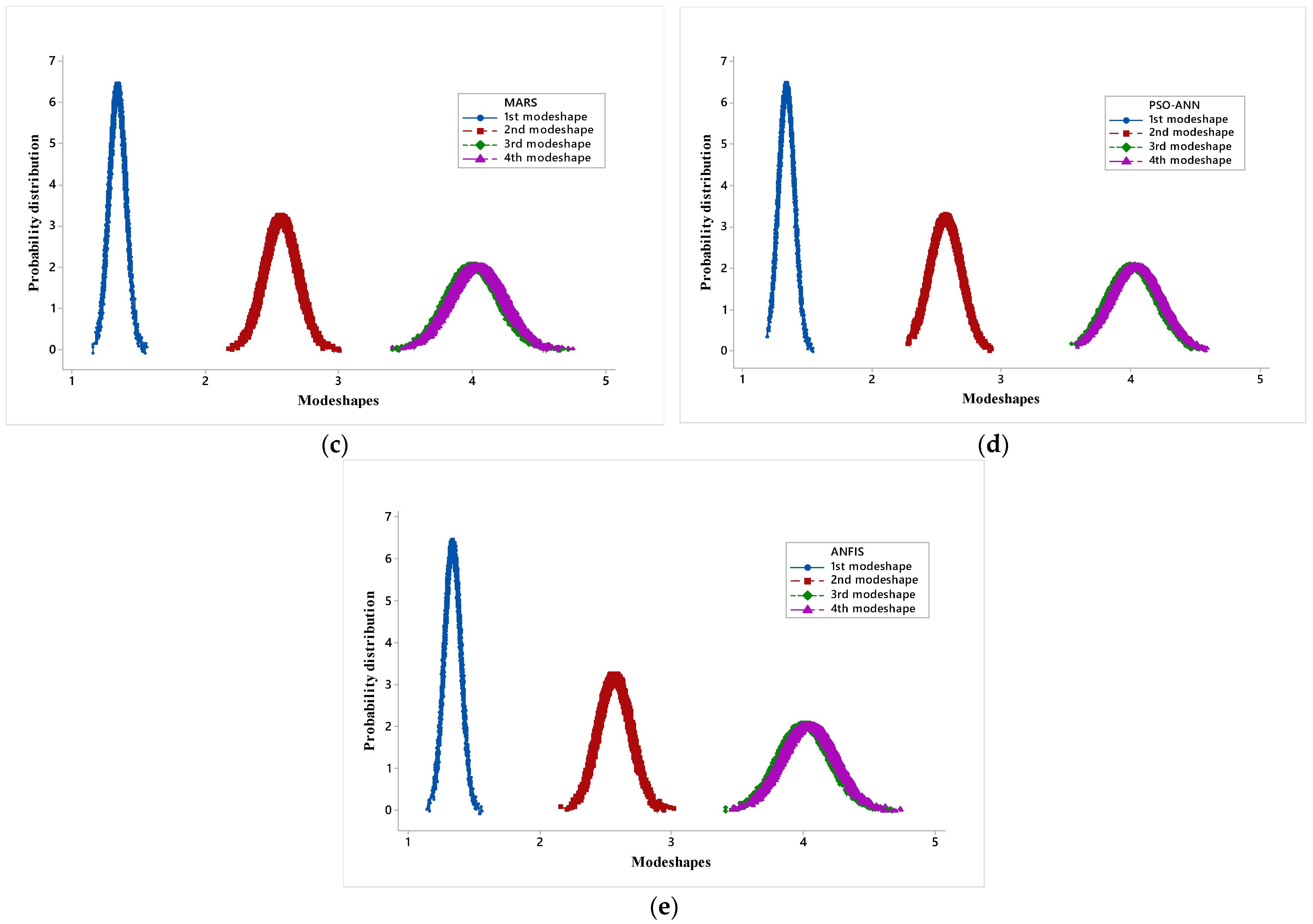1. Introduction
In the 20th century, a comprehensive application of evolutionary computation control has led to the evolution of very efficient finite element models to analyze complex structural problems. Regardless of the developments in the computation that thoroughly aids the finite element model, the computational cost and time to perform finite element simulations for the analysis of complex engineering structure make it infeasible and uneconomical. The dynamic response of angle ply laminates with uncertainties using FE software is a complex phenomenon and requires significant computational facilities. This makes the application of finite element models quite inappropriate in Monte Carlo Simulations (MCS). MCS requires very intensive computation. A huge number of simulations are required for MCS-dependent stochastic analysis. In such instances, it will be quite fruitful to work with soft computational models, i.e., the application of artificial intelligence in complex structural engineering problems. The application of soft computation models in characterizing the probabilistic reply produced due to the uncertainty present in composite structure has significant demand for assessing the overall response of the composite structure. A substantial application of the laminated composite plates in civil, aerospace, automobile, and marine works has made it a popular research subject so that optimum performance could be achieved. The vibration produced in the plate is a function of the stacking angle, skew angle, and material properties of the laminated composite plate. Hybrid means that more than one material is used in the production of a composite structure. A hybrid angle ply laminated composite plate provides excellent mechanical behavior. The basic characteristics of a hybrid angle ply laminated composite plate are affected by the sheet-to-sheet assembly of ply and deviations in material properties of ply along with the thickness. It has a complex production and fabrication process, which led to the variation in different structural properties from its mean value. Thus, an appropriate explanation and suitable understanding of the actual response generated due to variation produced are required. For this, it is primarily necessary to account for all the inherent variations produced in the production and fabrication process. With conventional methods like finite element analysis aided with Monte Carlo Simulation (MCS), stochastic vibration analysis of hybrid composite plate is uneconomical and time-consuming; henceforth, the application of the soft computing model for assessing the response generated in the plate due to unavoidable uncertainty could lead the researcher to the new insight. Since a variety of soft computation models are available, choosing a particular model for uncertainty evaluation in the composite structure may give rise to an obvious question of why this technique is better than others and on what basis the present soft computation model is selected. This question is answered with a proper literature survey and by showing the merits of the present soft computing model over the previously used model. Further, this paper presents a broad comparative assessment of a few state-of-the-art soft computation models with each other and with the most reliable Monte Carlo Simulation-Based Finite Element Models (MCS-FEM). Various soft computation models presented in the paper are Gaussian Process Regression (GPR), Multivariate Adaptive Regression Spline (MARS), Particle Swarm Optimization Aided Artificial Neural Network (PSO-ANN), and Adaptive Network Fuzzy Inference System (ANFIS). The first two soft computing models are state-of-the-art regression models and the other two models are an advanced version of Artificial Neural Networks (ANN) with efficient learning capability. A brief literature survey on the analysis of the composite structures and different soft computation modelling techniques are presented below.
Reddy and Khdeir [
1] presented buckling and vibration analysis of composite laminates under different boundary conditions. For the purpose, Reddy and Khdeir [
1] used Classical Plate Theory (CPT), first-order plate theory, and third-order plate theory and concluded that CPT over-predicts the natural frequencies, but at the same time, higher-order theory gives much more accurate results than CPT. Fares and Zenkour [
2] performed free vibration and buckling analysis of laminated composite plates with various plate theories and concluded that classical plate theory is inadequate in presenting an accurate response of the structure. Lin [
3] studied the reliability prediction of the laminated composite plate with random system parameters subjected to a transverse load. Using
C0 finite element and MCS, Singh et al. [
4] presented a study over nonlinear analysis of a composite plate with material uncertainty. Kayikci and Sonmez [
5] studied the design of composite laminates for the optimization of the frequency response of the composite plate. With random field properties and model uncertainty, Batou and Soize [
6] presented stochastic modelling and identification of an uncertain ambiguous computational dynamic model. Mahi et al. [
7] adopted the hyperbolic shear deformation theory for free vibration analysis of isotropic, FG, sandwich laminated composite plates. Using
C0 finite element method based on higher-order shear deformation theory (HSDT), Kumar and Chakrabarti [
8] performed a failure analysis of the laminated composite skew plate. Using nine-noded 2D
C0 isoparametric element, Ansari et al. [
9] studied CNT-reinforced functionally graded plates (FGP) for flexural and free vibration. Chaubey et al. [
10] presented the vibration of laminated composite shells with cut-outs using
C0 finite element formulation based on TSDT. Using first-order shear deformation theory (FSDT), Chaudhuri et al. [
11] studied five-mode shape analysis of hyper shell with cut-out and concluded that free vibration mainly depends upon boundary conditions rather than other parameters. With improved shear deformation theory (ISDT), Anish et al. [
12] analyzed bi-axial buckling of a laminated composite plate with cut-out and additional mass. By modelling uncertain material properties of FGPs with a multiple-imprecise-random-field model, Minh et al. [
13] performed a hybrid uncertainty analysis of FGPs. Using a four-variable quasiHSDT, Khiloun et al. [
14] presented an analytical model of bending and vibration of thick advanced composite plates. Using the smoothed particle hydrodynamics and finite element model, Zhou et al. [
15] analyzed laminated composite plates for bird impact resistance. Dhakal and Sain [
16] investigated the effect of unidirectional carbon fiber hybridization on the enhancement of mechanical properties of flax epoxy composite laminates. With hybrid titanium-carbon laminates subjected to low-velocity impact, Jakubczak et al. [
17] investigated it for various layer thicknesses. Ostapiuk and Bieniaś [
18] performed fracture analysis and shear strength of aluminium/CFRP and GFRP adhesive joint in fiber metal laminates.
GPR is a state-of-the-art regression model with a Bayesian and statistical theory framework [
19]. It is a kind of probabilistic regression that is extensively used for high-dimensional problems. When compared with other regression models like ANN, SVM, Random forest method, etc., GPR is easy to implement. It is very flexible and self-adaptive and hence regulates hyperparameters very conveniently. Due to these advantages, GPR is widely used to decipher approximation problems and capture the complex relationship between the variables. Besides, GPR gives uncertainty estimates for predictions and thereby makes the regression model more relatable and efficient. Anderson et al. [
20], using GPR, analyzed composite plate dynamics. Kang et al. [
21], using GPR, studied the stability evaluation method for slopes and observed that GPR gives a better result than ANN and SVM. Dutta et al. [
22] used GPR to predict the compressive strength of concrete and observed that the performance of GPR is better than ANN.
ANN is a powerful artificial intelligence tool used in many dynamic research areas. Many complex, diverse, and advanced applications of engineering follow the use of ANN. Though ANN captures most of the significant factors required to predict the input and output relationship, it has limitations of slow learning rate and getting trapped into local minima. To counter these limitations, the application of PSO (Particle Swarm Optimization), an optimization algorithm, has been done in the present work in conjunction with ANN. PSO is a robust global search algorithm, and it follows a commanding population-based stochastic approach to tune the weights and biases of ANN. Mahdiyar et al.’s [
23] hybrid ANN-PSO model has been successfully applied in engineering. The advantage of using the PSO algorithm over the other conventional training algorithm, for instance, Back-Propagation (BP), is that the potential solution will be flown through the problem hyperspace with accelerated movements towards the best solution. Thus, in ANN-PSO, PSO during the training phase results in obtaining the weights and biases configuration, which is associated with the minimum output error. Using ANN and GA, Roseiro et al. [
24] executed a study to determine the material constants of a composite laminate. Lopes et al. [
25] performed a reliability analysis of a laminated composite plate using finite element analysis (FEA) and ANN using MCS as a sampling method. Tawfik et al. [
26] used MCS, second-order reliability method (SORM), FEA, and ANN to implement reliability analysis of laminated composite plates in free vibration. Nguyen et al. [
27] used PSO to optimize the parameters of ANN for the problem of ground response approximation in short structures and concluded that it offers higher reliability than simple ANN.
MARS is a regression model. It relates response with multiple input variables (high-dimensional data). To establish the relationship between input and response variables, MARS employs the basis functions series. To obtain good results with MARS, input variables should not be highly correlated and no data should be missing. Francis [
28] in his work presented a comparison between Neural Network and MARS. For uncertainty quantification in a composite plate, Dey et al. [
29] employed several algorithms along with MARS. With MARS, ELM, and ANFIS, Dutta et al. [
30] predicted the strength of self-compacting concrete in compression and found that strength predicted by ANFIS is better when compared with ELM and MARS. To analyze the dynamics and stability of sandwich plates, Dey et al. [
31] employed MARS using arbitrary system parameters. To design the GFRP composite, Kalnins et al. [
32] employed MARS and partial polynomials.
Neuro-fuzzy schemes are widely used for those problems that have ambiguous and vague information. Artificial neural networks (ANNs) and fuzzy inference systems (FIS) are complementary machine learning technologies, and together these form adaptive intelligent systems. ANFIS is based on the Takagi–Sugeno fuzzy inference system [
33]. It translates the information learned during network training into a set of fuzzy rules and represents the input/output relationship more clearly. Ceylan et al. [
34] applied ANFIS and ANN to predict earthquake load reduction factors of a prefabricated industrial building and found that ANFIS is more efficient than ANN. Khademi et al. [
35] applied ANN and ANFIS for predicting the strength of recycled aggregate concrete. With uniaxial in-plane compressive load subjected to steel plates with pitting corrosion, Wang et al. [
36] applied ANFIS to predict the ultimate strength. Hassanzadeh et al. [
37], using ANFIS and TLBO, performed an experimental and numerical investigation to estimate bridge pier scour.
These metamodels give the approximate result of the analysis very quickly, efficiently, and also provide an understanding of the relationship between the various parameters. For characterizing the probabilistic behaviour of various mode shape of the present hybrid angle ply laminated composite plate, the employed soft computation metamodel does not require reliability function in advance as in the case of the first-order reliability method (FORM) and second-order reliability method (SORM). Along with it, these metamodels provide inclusive and well-organized sample space which provides an efficient result with negligible loss in accuracy. From the last few decades, the research community has given immense attention to the stochastic analysis of complex structures, which led to more convincing analysis and design of such a complex structural system. In the present paper, the authors have adopted a layer-wise random variable approach as material properties are varied layer-wise for Monte Carlo Simulation. Monte Carlo Simulation-based stochastic approach needs a large number of simulations for characterizing the behaviour of laminated composite plate due to the random nature of stochasticity present in input parameters, and in this context, soft computation models have gained popularity as they reduce the computational load to a great extent and characterize the structure very conveniently and efficiently since metamodels require a very limited number of simulations for doing so. Most of the investigation done for the laminated composite plate is deterministic and lacks a comprehensive explanation for structural responses generated due to stochasticity in material properties. To date, a study of stochastic analysis of the mode shape of a hybrid angle ply laminated composite plate is not found in the literature with the present state-of-the-art soft computing model. The novelty of the article is a probabilistic description of four-mode shapes of hybrid angle ply laminated composite plates with MCS-FEM and efficient metamodels GPR, MARS, PSO-ANN, and ANFIS and showing the advantage of metamodels over FE model, as in earlier published articles, no or very limited work is found on mode-shape analysis using soft computation metamodels. The present work is the first attempt on mode shape analysis of a hybrid angle ply laminated composite plate using 2D C0 FE formulation based on TSDT in conjunction with MCS-FEM, GPR, MARS, PSO-ANN, and ANFIS. A comparative assessment is made for the models employed in the present work and it is shown that the ANFIS model dominates the other models in terms of precision though the result predicted by each model is in agreement with the MCS-FEM. Concerning soft computation models, mode shape analysis of laminated composite plate is not sufficient, and henceforth, comparative analysis of these techniques concerning the accuracy and computational efficiency is very rare to find in published articles.
4. Results and Discussion
The FE model used in the present work is based on TSDT and has been used in the analysis of the fundamental natural frequency of hybrid angle ply laminated composite plate. The computer code of the above finite element formulation is done in FORTRAN 90. In
Table 2a, first, the convergence study of the developed finite element code is done to check the stability of the solution at a suitable mesh size. Further, the comparison of the present results with journal papers by Mandal et al. [
48] and Reddy and Chao [
49] has been done. Mandal et al.’s [
48] and Reddy and Chao’s [
49] work is based on first-order shear deformation theory (which considers linear transverse shear stress variation across the thickness of the plate) using finite element and closed-form solutions, respectively. The present results are based on third-order shear deformation theory (which considers the realistic parabolic transverse shear stress variation across the thickness of the plate) using finite element solutions; hence, slight variation is observed with reference papers by Mandal et al. [
48] and Reddy and Chao [
49].
The boundary condition used in the present study is:
The present work results are in good agreement with published results of Mandal et al. [
48] and Reddy and Chao [
49].
Following the deterministic approach, validation of the FE model developed for the present analysis is done. Few fundamental natural frequencies for simply supported boundary conditions at all four edges (SSSS) for two different aspect ratios 0.01 and 0.1 are evaluated and tabulated in
Table 2a.
In
Table 2b, the free vibration response of a simply supported cross-ply (0°/90°) square laminate obtained from present
C0 finite element model has been compared with the results of Serdoun and Hamza [
50] based on HSDT C
1 finite element model.
In
Table 2c, the free vibration response of a simply supported cross-ply (0°/90°) square laminate obtained from present
C0 finite element model has been compared with the results of Ganapathi et al. [
51] based on HSDT
C0 finite element model.
It may be observed in
Table 2b,c that present results are in good agreement with published works in the literature.
For the study, non-dimensional frequency is considered. The equation employed for calculation of non-dimensional frequency is given as:
where
λ is non-dimensional frequency,
w is frequency obtained by FE model,
a is the plate lateral dimension,
h represents the thickness of the plate,
ρ is density, and
E2 is Young’s modulus in the transverse direction.
The relative dimension of the plates studied in the present work is
a = 1,
b = 1, and the thickness (
h) is
a/100. Asymmetric laminated composite plate with four different layers of the lamina are analyzed in the present work with simply supported boundary (SSSS) conditions at all four edges. For the present plate, stacking sequences for all four laminae are 15°, 30°, 45°, 60° from the top layer to the bottom layer.
Figure 1 represents the present plate model.
Figure 2 shows a nine-noded isoparametric plate element that is employed to analyze the present plate model.
Relative material property and covariance incorporated agreeing with the industry standard for the present study are tabulated in
Table 3.
Figure 5 shows that for all four mode shapes, at an iteration equal to 3000, error becomes constant and concludes that 3000 MCS-FEM simulations are sufficient for describing the stochasticity in all four mode shapes of the present plate. Evaluation of 3000 MCS-FEM simulations is a very tedious task because it requires too much time (more than 24 h) to simulate on the workstation, which becomes a major drawback of finite element analysis. To sort out this limitation, soft computation metamodels are favored.
Figure 6 shows the ANN architecture employed in the present PSO-ANN metamodel.
The flow chart of the present study is shown in
Figure 7.
In the present study, stochasticity in the material property as described in random input generation is provided. The relative combined effect of the input parameters includes Young’s modulus of elasticity, longitudinal shear modulus, and Poisson ratio.
Different metamodels employed in the present work are GPR, MARS, PSO-ANN, and ANFIS. These metamodels are applied to explore the predictive and representative models that could be used in place of the finite element model. Corresponding to the stochastic input variables and frequency evaluated by MCS-FEM, four mode shape frequencies are predicted by the trained metamodels. For training the metamodels, design points are selected using a random variable framework. Design points from 30 to 300 are randomly selected to train the model, and then new results are predicted. Further corresponding to each mode shape predicted frequency, root mean square error (RMSE) value is evaluated to find out the appropriate number of design points which will be sufficient to train the metamodels.
Figure 8 presents the RMSE plot for various metamodels at a different number of design points for all four mode shapes.
That number of design points for which RMSE value is minimum for all four mode shapes is further used for training the metamodels from which new results are predicted. For training the GPR model, the number of design points used corresponding to the 1st–4th mode shapes are 120, 300, 150, and 300 respectively. For the MARS model, design points corresponding to the 1st–4th mode shapes are 210, 240, 240, and 240 respectively. For the PSO-ANN model, design points corresponding to the 1st–4th mode shapes are 210, 240, 240, and 240 respectively. Similarly for the ANFIS model, design points used for training corresponding to the 1st–4th mode shapes are 300, 300, 300, and 300 respectively.
The greater the deviation of points from the diagonal line, the poorer the model appears. Less deviancy represents a more accurate model, and it validates the use of a developed surrogate model.
The study is performed with stochastic variation in material property and with four mode shapes to observe the effect of stochasticity on various mode shape frequency of hybrid angle ply laminated composite plate.
Figure 9a–d shows the regression plot between MCS-FEM mode shape frequency and mode shape frequency predicted by the metamodels.
For the present work, initially, four-mode shapes are analyzed with MCS-FEM, and then corresponding mode shape frequency is predicted by trained metamodels. Each figure represents a particular mode shape regression plot for four different metamodels. The regression plot of the PSO-ANN model is much staggered when compared with the GPR, MARS, and ANFIS model because PSO only tunes the parameter of ANN but it does not add inference capability to ANN as in ANFIS; FIS (fuzzy inference system) provides a reasoning capability that enhances the prediction capacity of ANN. Further regression plots for GPR, MARS, and ANFIS models nearly overlap each other and are almost aligned along the diagonal line, which shows that these metamodels are better than PSO-ANN and that results predicted by these are similar to MCS-FEM. Here, it should be noted that PSO-ANN and ANFIS are modified forms of neural network and that these models learn from the input provided and further predict the results, whereas GPR and MARS are state-of-the-art regression algorithms.
Figure 10a–d represent the probability distribution plots for each mode shape and all five different models employed in the present study i.e., MCS-FEM, GPR, MARS, PSO-ANN, and ANFIS.
MCS-FEM probability distribution plot is a benchmark plot, and from this, probability distribution plots obtained from other models are compared. The probability distribution plots based on the five models nearly overlap, but it can be observed that tail endpoints of the plot lack the frequency predicted by the PSO-ANN model, whereas the frequency predicted by the rest of the model uniformly overlaps the MCS-FEM probability distribution plot. This shows that GPR, MARS, and ANFIS performances are much better than the PSO-ANN, and ANFIS is the most accurate.
Probability distribution plots for four mode shapes frequencies of a simply supported hybrid angle ply laminated composite plate due to combined variation in the material property (
S(
)) are presented in
Figure 11a–e.
As the mode shape increases, a trend is noticed that the mean and response bound increases. Here again, it can be observed that the probability distribution plot of the mode shape frequency obtained by the PSO-ANN model is somewhat different from MCS-FEM as at tail points it does not coincide with MCS-FEM. Whereas for the rest of the metamodels, the plots are nearly identical to the MCS-FEM plot. This again validates the use of metamodels in stochastic analysis of a hybrid angle ply laminated composite plate and shows that of the four models, ANFIS is most accurate in predicting the results and PSO-ANN is least accurate.
Statistics of four-mode shape frequencies obtained by MCS-FEM and frequency predicted by metamodels are summarized in
Table 4,
Table 5,
Table 6 and
Table 7. It can be observed that the result predicted by the metamodels agrees with MCS-FEM. Parameters like maximum value (Max), minimum value (Min), mean value (Mean), and standard deviation (SD) of GPR, MARS, and ANFIS are nearly identical to MCS-FEM, whereas PSO-ANN deviates from the MCS-FEM value. Of all four metamodels, the best result is obtained with the ANFIS model, and the result predicted by PSO-ANN is close to MCS-FEM, but its precision, when compared with the rest of the three models, is less. These tables further validate the use of metamodels for stochastic analysis of the mode shapes of a hybrid angle ply laminated composite plate.
Table 8,
Table 9,
Table 10 and
Table 11 presents various statistical parameters of each mode shape that shows the precision level of various soft computation metamodels. Different statistical parameters calculated are root mean square error (RMSE), root mean square error to observations standard deviation ratio (RSR), Nash Sutcliff coefficient (NS), variance account factor (VAF), maximum determination coefficient value (
R2), performance index (PI), and adjusted determination coefficient value (Adjusted
R2). Optimum values of the statistical parameter presented in
Table 8,
Table 9,
Table 10 and
Table 11 are as follows: RMSE should be close to 0, NS value should be close to 1, RSR should be close to 0, VAF should be close to 100,
R2 value should be close to 1, R should be close to 1, adjusted
R2 should be close to 1, and PI should be greater than 1. From
Table 8,
Table 9,
Table 10 and
Table 11, it is observed that although every model performance is good, and ANFIS dominates the rest of the metamodels.


